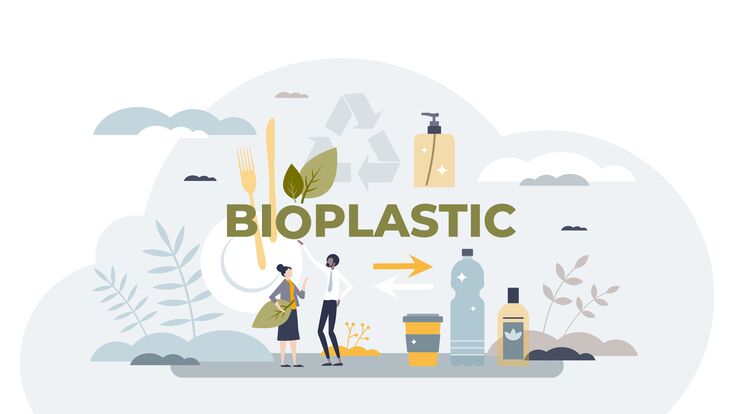Bioplastics : "Many bioplastics can be mechanically recycled together with their conventional counterparts."

What is the difference between bio-based plastic and bioplastic?
Bioplastics is not just one single material. They comprise a whole family of materials with different properties and applications. According to European Bioplastics, a plastic material is defined as bioplastic if it is either biobased, biodegradable, or features both properties.
The term ‘biobased’ means that the material or product is (partly) derived from biomass (plants). Biodegradation is a chemical process during which microorganisms that are available in the environment convert materials into natural substances such as water, carbon dioxide, and biomass. The biodegradation process depends on the surrounding environmental conditions (e.g., location or temperature), the material, and the application.
Read more on the topic of bioplastics here!
What are the feedstocks for bioplastic?
Today, biobased bioplastics are mostly made of carbohydrate-rich plants, such as corn or sugar cane, the so-called agri-based feedstock. This feedstock is currently the most efficient to produce bioplastics, as it requires the least amount of land to grow and has the highest yields. The bioplastics industry is also researching the use of non-food crops, such as wood, waste materials, and CO2 with a view to its further use to produce bioplastic materials. In 2022, the global production capacities of bioplastics amounted to 2.2 million tonnes. This translates to approximately 0.8 million hectares of land used for the cultivation of agri-based feedstock.
Consequently, the area required to grow sufficient feedstock for today’s bioplastics production just reaches a little bit more than 0.01 percent (0.8 million ha) of the global agricultural area of 5 billion hectares. Metaphorically speaking, this ratio correlates to the size of an average cherry tomato next to the Eiffel Tower. There are also a small number of fossil-based bioplastics that feature biodegradability properties but, thus, are made from conventional resources. However, it is likely that those bioplastics will be at least partially biobased in the future as well.

Is bioplastic recyclable and if so, how often can it be recycled?
Bioplastics, depending on the respective material, can be mechanically, organically (industrial composting and anaerobic digestion), and/or chemically recycled. So-called drop-ins, e.g., bio-PE or bio-PET, can be mechanically recycled together with their conventional counterparts as they show the same chemical structures and physical properties. There is no impact on quality when mixing these types of fossil-based and biobased plastics during the mechanical recycling process. Industrially compostable bioplastics certified according to EN 13432 can be treated together with biowaste in an industrial composting plant where they will be converted into water, carbon dioxide, and biomass. Chemical recycling is an option for bio-based plastics to the same extent as it is for fossil-based plastics. In any case, all bioplastics and conventional plastics can be collected together and later separated. The necessary sorting systems are available, e.g., using near-infrared (NIR) technology. Hence, the alleged contamination of recycling streams by compostable plastics is based on misconceptions and false information and concerns, if at all, all kinds of polymers, not only compostable ones.
Are existing recycling facilities able to recycle bioplastic?
Many recycling facilities are able to recycle bioplastics and a lot of them already actively recycle drop-ins.
The alleged contamination of recycling streams by compostable plastics is based on misconceptions and false information and concerns, if at all, all kinds of polymers, not only compostable ones.Oliver Buchholz, European Bioplastics
Even though it is advertised as compostable, many composting facilities report, that they need to sort it out after the composting process. How is it tested and why do you think it causes such problems in composting facilities?
If bioplastics have proven their compostability according to international standards, they can be treated in industrial composting plants. Plastic products can provide proof of their compostability by successfully meeting the harmonised European standard, EN 13432 or EN 14995. These two standards define the technical specification for the compostability of bioplastics products. European Bioplastics only accepts and promotes the use of compostable plastics that are certified according to these European Union standards or that meet the same requirements. Currently, there is very little data that support these allegations concerning the performance of compostable plastics in industrial composting facilities. The technical standards in the EU composting landscape alone are already very different. Some facilities are very old and in no way respond to the current requirements of a modern recycling system. If you look at countries, such as Italy where politics is supporting the use of bioplastics by establishing clear framework conditions and investing in an adequate waste management infrastructure, recycling rates of biowaste including compostable plastics are significantly higher than in other EU Member States.
How much of the plastic produced (in Europe, worldwide) currently is bioplastic?
Bioplastics currently represent still less than one percent of the more than 390 million tonnes of plastic produced annually. In 2022, the global bioplastics production capacity was around 2.23 million tonnes and is set to further increase significantly to approximately 6.3 million tonnes in 2027.
How much land is used for bioplastics feedstock and how much will and can it grow?
The land used to grow the renewable feedstock needed to produce bioplastics is estimated to only slightly increase to approximately 0.8 million hectares in 2022. This accounts for around 0.015 percent of the global agricultural area of roughly 5.0 billion hectares. Along with the projected increase of bioplastics production in 2027, the land use share is expected to increase to around 0.06 percent. In relation to the available agricultural area, this share is minimal. Thus, there is no competition between the renewable feedstock for food and feed and the production of bioplastics.
Does it make sense to use arable land to grow bioplastic feedstock instead of food?
If you look at the data, that question doesn’t even arise as the share of arable land used to produce bioplastics is so small. I repeat, there is no competition between the renewable feedstock for food and feed and the production of bioplastics. Additionally, research for nonagricultural feedstock is advancing constantly. However, the share of arable land (3.3 billion ha) used for pastures should be the focus of the debate, instead.
Currently, bioplastic is mainly used for single-use items. But this does not change anything in the system, the amount of waste is not reduced. Is the problem only being shifted?
European Bioplastics doesn’t promote the complete substitution of all conventional plastics with bioplastics. This would indeed not solve the challenges related to plastic waste that we are facing. We must reduce the use of plastic and we must reuse more plastic items. In this regard, we support the strategic approach of the European Union to tackle the environmental challenges related to plastic waste. However, we cannot, and we don’t have to completely waive all products made from plastic. In many cases, there is no alternative material that provides the same properties as plastic. Additionally, there are many situations where only a single-use item made from plastic makes sense, e.g., because it is the only material that meets the strict safety requirements related to health safety. Reuse is not always environmentally superior to single-use. Given the fact that we will still need a significant amount of plastic and at the same time need to become more independent from
fossil resources and to reduce our CO2 emissions, biobased, biodegradable, and compostable plastics can make significant contributions to achieving the ambitious environmental goals of the European Union. However, maybe it is important to mention that many sectors outside of (single-use) packaging are already using bio-based plastics such as the automotive sector, toys industry, or building and construction.
Why is bioplastic better than normal plastic?
We already talked about the reduction of our independence from fossil resources and the great need to reduce our CO2 emissions. In contrast to conventional plastics, bioplastics can make significant contributions to their reduction. There is a bioplastic alternative for almost every conventional plastic material. In some cases, the bioplastic alternative has the same
chemical structure as its conventional counterpart with the same material properties.
However, some bioplastics even show additional properties, e.g., polyethylene furanoate (PEF) could substitute PET in the future, as its barrier properties related to vapor permeability are more advanced compared to conventional PET.


